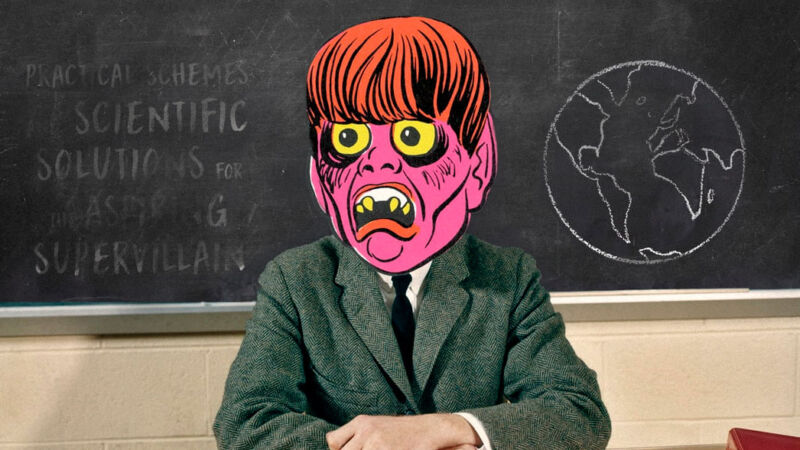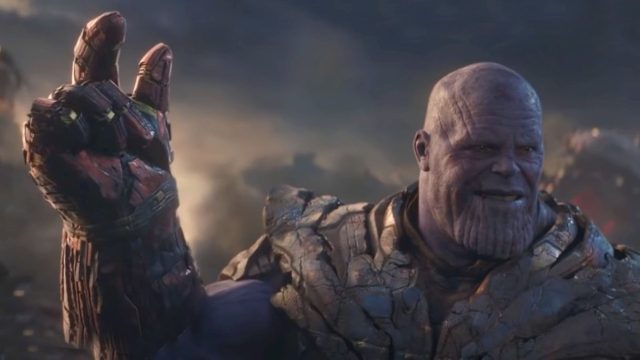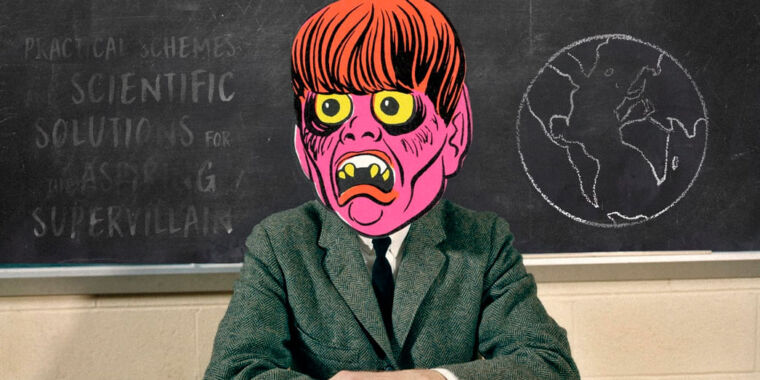
Ryan North, tweaked by Aurich Lawson
Are you a fan of superhero comics who identifies more with the Big Bad? Do you dream of riding around on your own cloned dinosaur and kicking back after a long day’s evil-doing in your floating, secret supervillain base? Good news: Ryan North has got you covered. He’s the author of a new book called How to Take Over the World: Practical Schemes and Scientific Solutions for the Aspiring Supervillain, and there’s frankly nobody better qualified to guide the reader through a step-by-step process toward world domination.
North is something of a webcomic pioneer, having started Dinosaur Comics (aka Qwantz) way back in 2003. The strip’s signature six panels are the same every time, consisting of simple dinosaur clip art that North found on a CD; only the text changes. T-Rex is the main character, with Utahraptor appearing as a comic foil in the fourth and fifth panels. A third dinosaur, Dromiceiomimus, is featured in the third panel. North has said he did it this way because he can’t draw. It’s been a staple of nerdy webcomics ever since.
That early success led to North becoming the writer for several Marvel Comics series, most notably the Eisner Award-winning The Unbeatable Squirrel Girl (a personal favorite) and Jughead. It was only a matter of time before he wrote his first popular science book: the delightfully irreverent (and best-selling) How to Invent Everything: A Survival Guide for the Stranded Time Traveler. In each chapter, North demonstrated how the reader could invent any number of modern conveniences from first principles, as well as answering the burning question of whether it’s possible to tame a giant wombat.
How to Take Over the World takes a similar approach, providing a practical blueprint to help readers become the criminal mastermind of their dreams. The supervillains in comic books invariably get their comeuppance when the superheroes foil their evil plans. North asked himself a different question: what if the supervillain didn’t have to lose?
In How to Take Over the World, North outlines practical ways to set up a cool secret base; start your own country; hold the weather hostage; destroy the Internet; and become immortal, dutifully summing up the pros and cons of each scheme. And yes, one chapter covers cloning a dinosaur. “Every supervillain wants to make a good entrance,” North writes. “The best entrance it’s possible to make is on the back of a dinosaur.” The catch: funding. North estimates that aspiring supervillains will need $55,434,551,900 USD to actually bring every scheme in the book to fruition, an amount only 20 people currently living on Earth could afford.
Ars sat down with North to learn more.

Ars Technica: What was your inspiration for writing about supervillainy?
Ryan North: The first book, How to Invent Everything, used a fictional premise of going back in time and finding your time machine is broken to justify learning about the nonfiction. I really liked that. The fictional coding for this new book was, Okay, so I’m a comic book writer. I’ve come up with all these super villainous schemes, I’ve written them all down and priced them out, and now we can find out what we actually need to dig to the Earth’s core, have a secret base, ride around on a dinosaur, and all that stuff. Once you have that fictional premise, it gives you a reason to care about all the cool science and technology.
I like the empowerment one feels at the end. If you read a book about being trapped in the past, you know that if you did get sent back in time, you’d be a really competent time traveler. If you read a book about taking over the world, now you know that if you had $64 billion, then you could work on sending information into deep time, or trying to figure out if we could solve the problem of human mortality. The fun of it is what attracted me to the idea.
Ars Technica: Every good superhero needs a good supervillain. Why it that so important, and what makes the best kind of supervillain? In the book you talk about “enlightened supervillainy.”
Ryan North: It’s important because the hero needs someone to fight, to challenge them. The best villains are the ones where you think, “Well, he’s kind of got a point there. He’s going about it the wrong way, but I see where he’s coming from.” That’s the type of villainy I tried to capture in the book. I didn’t want garden variety villainy where you’re just robbing banks or taking people hostage. That felt too close to the actual, horrible things in the world. I wanted the kind of fantastical super villainy where you’re taking over a floating base and things like that.
These villains are a lot like the heroes. Both want to change the world and want to do it outside of existing power structures. They see an issue, a problem, that they think they can fix, and they try to do it. A hero does it in a way that is ultimately beneficial to everyone, and a super villain tends to do it in a bit more of a self-centered way. But the goal is usually similar.

Marvel Studios
If SpiderMan was trying to stop people from ever having to die, that would be a positive. If Dr. Doom was trying to become a moral person for his own selfish reasons, that would be a negative for society. Although in the book, I argue that if people were immortal there would be a ton of downsides, and it actually is the most ethical thing to only become immortal yourself and then keep it a secret from everyone else. All the benefits, none of the downsides.








